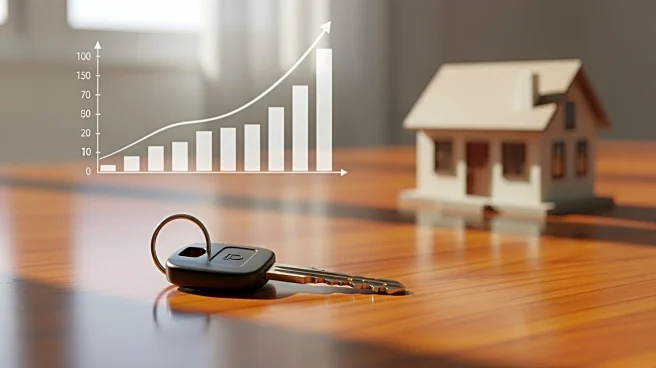What's Happening?
The National Association of Realtors announced that sales of previously occupied U.S. homes increased by 1.5% in September compared to August, reaching a seasonally adjusted annual rate of 4.06 million
units. This marks the fastest sales pace since February, driven by declining mortgage rates and a greater availability of properties. The national median sales price rose 2.1% year-over-year to $415,200, continuing a 27-month trend of annual price increases. Despite the rise in sales, the figure slightly missed economists' expectations of 4.07 million units. The housing market has been recovering from a slump that began in 2022 due to rising mortgage rates. Recent declines in mortgage rates, influenced by the Federal Reserve's interest rate cuts, have improved purchasing power for homebuyers, although borrowing costs remain high for many Americans.
Why It's Important?
The increase in home sales is significant as it indicates a potential recovery in the U.S. housing market, which has been struggling due to high mortgage rates and limited inventory. Lower mortgage rates enhance affordability, potentially boosting consumer confidence and spending in the housing sector. However, the persistent high prices and limited supply, especially in affordable housing, continue to challenge first-time buyers. The broader economic implications include potential stabilization in the real estate market, which could influence related industries such as construction and home improvement. The trend of cash purchases, accounting for 30% of sales, reflects ongoing economic uncertainty and the financial strategies of buyers.
What's Next?
Mortgage rates are expected to continue easing, which may further stimulate home sales. However, economic uncertainty could temper buyer enthusiasm, leading to steady sales activity through the fourth quarter. The housing market's performance will likely depend on broader economic conditions, including employment rates and consumer confidence. Stakeholders such as real estate agents, homebuilders, and policymakers will be closely monitoring these trends to adjust strategies and policies accordingly.
Beyond the Headlines
The shift towards cash purchases highlights a significant trend in the housing market, suggesting that buyers are seeking to avoid high borrowing costs amid economic uncertainty. This trend could have long-term implications for the housing market, potentially influencing pricing strategies and the availability of financing options. Additionally, the chronic shortage of affordable homes continues to impact first-time buyers, raising concerns about housing equity and accessibility.













